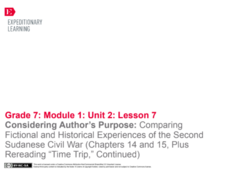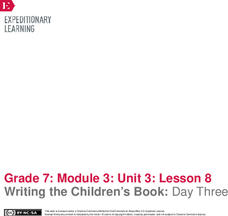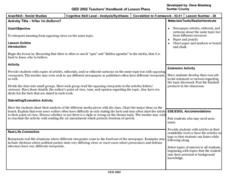EngageNY
Reading for Gist and Answering Text-Dependent Questions: Local Sustainable Food Chain
Readers use sticky notes and a Reading Closely: Guiding Questions handout to record the gist of a different section (pages 161-166) in The Omnivore’s Dilemma. They then pair up and share their ideas. To end the lesson plan, readers...
EngageNY
Final Performance Task: Sharing Visual Representations of Position Papers
It's time to put down those pencils and celebrate! Scholars share the visual representations of their position papers with the class. They participate in a gallery walk to view each other's work, writing a piece of praise for their...
EngageNY
End of Unit 3 Assessment: Using Strong Evidence
Young poets view a model two-voice poem while discussing capitalization and punctuation. Pupils also complete an end-of-unit assessment about using strong evidence to support a literary analysis.
EngageNY
Establishing Routines for Discussing A Long Walk to Water (Chapter 6)
Middle schoolers use a reader's dictionary to locate words they do not know in chapter 6 of A Long Walk to Water. They then turn attention to gist and work on a Salva/Nya anchor chart to record what happens to the characters....
EngageNY
Comparing Historical and Fictional Accounts: Second Sudanese Civil War (Chapters 14 and 15, Plus Rereading “Time Trip”)
Let's compare! One pair of scholars adds to the Salva/Nya anchor chart by gathering evidence about the characters from chapters 14 and 15 of A Long Walk to Water. The rest of the class pairs work on adding to the Survival anchor chart....
EngageNY
End of Unit 2 Assessment, Part 1b: Writing Introduction and Conclusion
Writers continue looking at the rubric for their A Long Walk to Water essays. This time, they analyze the demands for the introduction and conclusion paragraphs. Pupils compare the rubric to the opening and closing of the model...
EngageNY
Writing an Argumentative Essay: Crafting a Claim
As scholars prepare to craft their essays based on Katherine Paterson's Lyddie, they learn about using compelling reasons in their writing. Next, they develop a claim about whether Lyddie should sign a petition to speak out against...
EngageNY
Writing the Children’s Book: Day Three
Illustrations are a key feature of children's books. Using the resource, pupils learn about adding illustrations to their children's books. Next, as they complete their storyboards and work on their second drafts, they consider their...
EngageNY
Gathering Information about Screen Time: Assessing and Reading Internet Sources, Day 2
Calling all researchers! Using the resource, scholars continue conducting independent Internet research about a chosen research question. As they browse the web in search of articles to answer their questions, pupils paraphrase their...
EngageNY
Clarifying Thinking on Water Management: Revisiting the Gallery Walk
One, two, three, go! Scholars gather in triads and number themselves one to three. Each number is responsible for sharing a section of the map homework completed the night before as learners discuss domain-specific vocabulary terms using...
EngageNY
Finding Evidence of Carl Hiaasen’s Perspective in Flush
Mix and mingle. Scholars travel around the room to music stopping to meet with a classmate when the music stops. They answer questions about Flush at each stop. Learners then work together to identify the evidence they used to determine...
EngageNY
Making Inferences: What Motivated Philo Farnsworth?
Learners continue their work in The Boy Who Invented TV by examining pages 14-17. They work together to determine the gist of the section during a first read then complete a second read to make inferences, create a summary, and...
National Endowment for the Humanities
“From Time to Time”: Presidents and Communicating with the Public
While the Constitution requires a "State of the Union" address, it doesn't give many details. In fact, it wasn't until Woodrow Wilson that the periodic update to Congress was given in-person. Using primary sources, recordings and...
US House of Representatives
A Growing Diversity, 1993–2017
Connect current events to the roles of AAPI members in Congress. Activities include tracing the impact of the Vietnam War on today's representatives. Learners have various options to explore, including role-play exercises and creating a...
Curated OER
The Story of How Deerfield Came to Be
Eleventh graders explore how the native peoples had lived in the Connecticut Valley for nearly 10,000 years, prior to the English settlement and how their culture and life ways were markedly different from that of the English settlers.
Curated OER
The President of The United States
In this conversation practice worksheet, students are provided with a mock agenda for a week for the President of the United States. Students work in teams to discuss the agenda and practice conversation skills.
Curated OER
Historical Witness: Social Messaging
Students examine the persuasive techniques of leaders. In this propaganda lesson, students discover the practices that Louis XIV and Caligula used to persuade others. Students watch "The Merchants of Cool" and discuss propaganda used...
Curated OER
The Battle of the Experts
Learners view the "Smoking Gun" video as an illustration of someone claiming to be an expert who really is not one. They discuss the fact that some experts also come with biases and personal agendas. Students research experts from...
Curated OER
The Great Society and A Thousand Points of Lights
Students compare 2 preseidental speeches. In this presidential agenda lesson, students compare and contrast a Lyndon B. Johnson speech with a George H. W. Bush Speech.
Curated OER
A Life in Politics
Young scholars answer a quiz about congressional leaders. They research former majority leaders and create charts about them. They write letters to the current majority leader about a current issue.
Curated OER
Queen of England's Government Plans
Students view the Queen of England's annual speech to determine the government's plans for change over the next year. They test their knowledge of the ceremony with a true/false quiz and then decide on priorities for their school. They...
Curated OER
Using Current Events to Understand Elections
Eleventh graders explore the the major phases of the electoral process for president. For this US Government lesson, 11th graders compare and contrast the delegate system of nomination and the electoral college.
Curated OER
Civil Rights and the ADA
Students examine and discuss the 14th and 15th amentments, and evaluate the agendas of Americans from underrepresented groups in the quest for civil rights. They conduct Internet research and create essays or posters regarding Civil Rights.
Curated OER
Who To Believe?
Students interpret meaning from opposing views on the same topic, and discuss that there is often so much "spin" and "hidden agendas" in the media.
Other popular searches
- Time Management Daily Agenda
- Congressional Agenda
- Time Management Dialy Agenda
- Sample Open House Agenda
- Open House Agenda
- Agenda for Meeting
- Agenda 21
- Pictorial Agenda
- Government's Agenda
- Media's Agenda
- Political Agendas
- Using an Agenda























